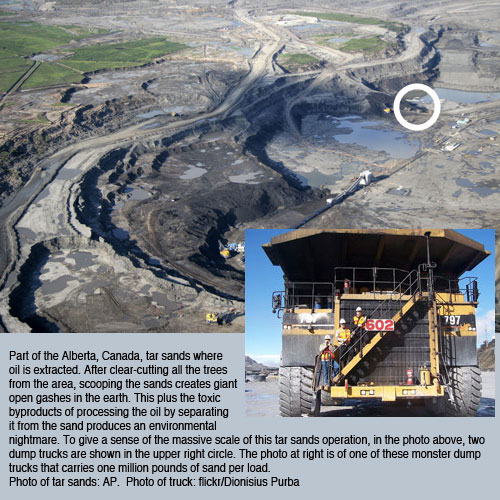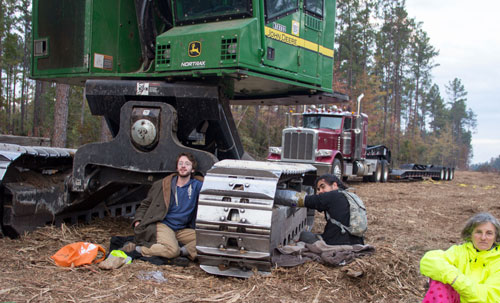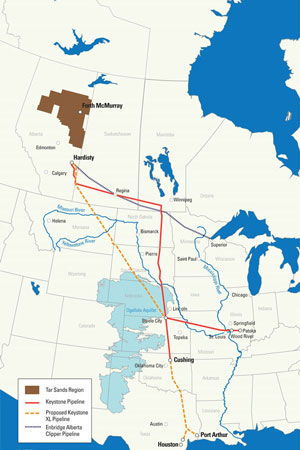The Keystone XL Pipeline: An Urgent Danger to the Environment
May 19, 2013 | Revolution Newspaper | revcom.us
Things are coming to a head in the struggle over the building of the Keystone XL Pipeline. Keystone XL would increase by 830,000 barrels a day the flow of tar sands oil from Alberta, Canada, where it is extracted, to Steele City, Nebraska. From there, it would be piped to the U.S. Gulf Coast for refinement. A decision on the pipeline is expected from President Obama any time between now and the fall.
Moving ahead with this pipeline would be an environmental nightmare, and would further escalate the current environmental state of emergency. (See "State of Emergency! The Plunder of Our Planet, the Environmental Catastrophe & The Real Revolutionary Solution."). Carbon dioxide emissions are the main factor in climate change, rapidly putting the lives of billions of people on this planet in danger due to rising oceans, rising temperatures and more violent weather, melting ice caps, and other environmental changes. Fully extracting and burning the entire pool of carbon from the Alberta tar sands would greatly contribute to global warming and the danger of runaway climate change. The increase in production, transport, and refinement of tar sands oil added by the Keystone XL pipeline alone would put 181 million metric tons of carbon dioxide into the atmosphere each year. That is equivalent to the carbon dioxide produced annually by 37 million passenger cars or 51 coal plants.
Experts agree that a global temperature rise of about 3.6 degrees Fahrenheit (F)—or 2 degrees Celsius (C)—would bring about even more, and faster, disastrous climate change than the planet is experiencing now.

Tar Sands Destruction, "Extreme Energy," and the Environmental Future
Accept Keystone XL? Or Fight It!
Despite the frightening reality of climate change we are facing, the U.S. State Department review on Keystone XL argues that it represents no real climate danger because the extraction of Tar Sands oil is inevitable and will continue whether Keystone XL is built or not. And if not tar sands oil, the U.S will get oil from somewhere else. The whole argument from the State Department and other forces and figures in the U.S. ruling class is, "Get real, if Keystone XL isn't built, Canada will build other pipelines or ship it by rail, truck, and barge. If we don't get it, they'll sell it to China."
But the logic that people should just accept this—and make no mistake, this same argument has and will be made about every other fossil fuel project to come—comes from the logic and interests of an economic and political system that can only turn everything, including nature, into a commodity and a source of profit-making. Accepting "business as usual" on this, and everything else they plan, means accepting the accelerating destruction of earth's environment. Any system that says destruction of the environment is inevitable and should be accepted, or that throws people out of work and then says the only way to employ them is in jobs that can only further destroy ecosystems and our collective future, is completely illegitimate. This system has proven its complete illegitimacy and inability to protect living ecosystems.
What these arguments show is not that we should accept Keystone XL, but that it must be fought and stopped, and that this fight has to be connected to a much larger fight against all the environmental destruction brought down by this system and against the system of capitalism-imperialism itself. And that this fight must be part of building a movement for revolution that can bring into being a system of socialism aimed at communism, where the destruction of the environment would no longer be considered acceptable or the inevitable outcome of the very operations of the economy. (See the Constitution for the New Socialist Republic in North America (Draft Proposal).)
The stakes are high in this battle. It is connected to a much larger battle over the continued burning of fossil fuels and the environmental future of the planet.
Tar sands extraction and processing is now the largest energy and capital investment project in the world. The tar sands deposits are the third largest oil reserves in the world. Already 1.8 million barrels of oil per day are extracted in the tar sands, but there are plans to expand this to five million barrels by 2030. Keystone XL is one big part of moving toward this.
The tar sands projects are one example of how capital is racing to exploit fossil fuels that were previously inaccessible or too expensive to produce. The oil here is in the form of thick gobs of bitumen tar, mixed in with sand. Extraction and processing is expensive and uses immense amounts of energy and water, but is now profitable because of the high price of oil. The tar sands reserves represent a huge source of profit-making for U.S., Canadian, and other economic interests. Tar sands oil is now the largest single source of oil fueling the U.S. capitalist economy. Control of oil and oil markets is also foundational to competition over control of the world economy. The U.S. sees oil from Canada as a stable, reliable source of energy from a "strategic partner," in a world filled with instability.
Huge amounts of oil in the form of tar sands and oil shale have now also been discovered in the U.S. itself. Big capitalist interests are salivating to exploit these as well. The U.S. is poised to become the world's largest oil producer by about 2020 according to the International Energy Agency.
An Environmental Catastrophe in Progress
Besides the climate "carbon bomb" the tar sands represents, the project is already an environmental catastrophe in progress. Oil extraction by U.S. and other Western oil companies has created environmental disasters in the Niger Delta in Africa and other oppressed countries around the world. (See "The Gulf of Mexico and the Niger River Delta: oil spills worlds apart" from A World To Win News Service.) Such disasters are now a danger to, or happening more and more in North America.
From the Gulf Coast to Alaska, from the mountains of the Southeast to the vast new reserves being turned up in the Midwest and throughout the West, there is a relentless war being planned and waged to wrench coal, gas, and oil out of the earth and oceans—a war that is increasingly ravaging the environment and many people's lives.

November 2012, Texas: Police arrested and pepper sprayed blockaders from the Tar Sands Blockade Coalition who locked themselves to hseavy machinery used for construction of the pipeline route. Photo: tarsandsblockade.org
In late March Exxon's Pegasus pipeline spilled thousands of barrels of tar sands oil into a suburban community and surrounding wetlands in Mayflower, Arkansas. Around the same time a train derailed in Minnesota, spilling at least hundreds of gallons of tar sands oil. These spills come after at least a dozen others in tar sands pipelines over the last several years, including an infamous and devastating spill of one million gallons from an Enbridge-owned pipeline into the Kalamazoo River in Michigan in 2010. Much of this spill has not and apparently cannot be cleaned up, because when the tarry oil spills out into water, it turns solid and so simply sinks. Now the river bottom is filled with this toxic crap.
Vast regions of Canada's huge boreal forest—upon which indigenous people depend for survival—are being torn down. Lakes of contaminated toxic byproducts of the extraction process cover 50 square miles of the former Alberta wilderness. Lakes and rivers are being poisoned with polycyclic aromatic hydrocarbons (PAHs)—compounds known to cause cancer. For years the Canadian government and fossil-fuel companies have claimed any of these compounds present are just there because of natural processes that release the compounds from the bitumen. But now two scientific studies have shown PAHs have increased with tar sands extraction—contaminating the Athabasca River downstream of tar sands projects and also area lakes as far as 50 miles away. Cancer rates among indigenous people in the area have also risen.
The Growing Environmental Resistance and the Potential for More
Carbon Dioxide Levels Reach New Milestone
On May 9, scientists monitoring carbon dioxide in the atmosphere from measurements taken at the Mauna Loa observatory in Hawaii announced a frightening new milestone. Carbon dioxide (CO2) levels have now reached 400 parts per million (ppm). CO2 is one of a number of greenhouse gases whose levels are rising in the atmosphere as a result of the burning of fossil fuels, deforestation, and other practices endemic to the operation of the global capitalist economy. Sunlight passes through greenhouse gases but the gases trap certain wavelengths of sunlight that are radiated back off the earth's surface. This causes the earth to warm. Measurements at Mauna Loa started in 1958 and were at that time 316 ppm, up from an estimated 270 ppm in the 1700s, before industrialization. Each year with the continued burning of fossil fuels, greenhouse gases rise. And in 2012, annual emissions of carbon dioxide rose to a new record high, increasing 2.6 percent from 2011.
Levels this high have not been seen in the history of human existence. In fact levels this high have not been seen on earth in 3-5 million years. The last time CO2 was this high, according to Scripps Institute of Oceanography paleobiologist Richard Norris, "There were camels and forests in the Arctic, the tropics were locked in a near constant el Niño—the kind that typically floods the western U.S.—and large expanses of the U.S. East Coast, Florida and the Gulf States were underwater." While the number 400 ppm doesn't mean some specific, definite event will happen or represents a number more significant than 398 or 402 ppm, the level of gases it represents and the rate of increase of greenhouse gases occurring indicates a dire situation indeed for humanity and for living ecosystems in terms of the danger of catastrophic climate change.
In the face of all this destruction, there is resistance on many fronts. This past February, tens of thousands turned out for the largest rally against climate change in U.S. history in Washington, DC, called by 350.org, the Sierra Club, and others. Campaigns, groupings, and actions are proliferating in many parts of the U.S.—opposing hydraulic fracturing (fracking) for gas and oil, against coal extraction and mountain-top removal, etc. Thousands have come to speak out in hearings in Washington State against plans to increase export of coal from ports on the West Coast to Asian markets.
Before the election, Obama initially withheld approval for Keystone XL until there could be "further review." He then quickly announced plans to fast track the building of the southern portion of the pipeline from Cushing, Oklahoma, to the Gulf Coast. Obama personally went to Cushing in March 2012 to announce his approval for the project, saying, "And today, I'm directing my administration to cut through the red tape, break through the bureaucratic hurdles, and make this project a priority, to go ahead and get it done."
In response, new groups and forms of resistance developed. Tar Sands Blockade and Great Plains Tar Sands Resistance developed a campaign of nonviolent civil disobedience to stop this southern section of Keystone XL. They occupied trees outside Diboll, Texas—at great personal risk—to block construction. Activists locked themselves to equipment and took many other creative actions to try to stop the pipeline. People from around the country were inspired to come and join them. The blockaders were hit with vicious repression. People who locked themselves to pipeline construction equipment were basically tortured by police agencies—pepper sprayed and Tased, and subjected to brutal pain compliance tactics to wrench them free. Activists were called "eco-terrorists" and hit with lawsuits with fines of millions of dollars for the "crime" of standing up for the planet unless they agreed to stop protesting.
In the wake of this, Tar Sands Blockade has gone nationwide. In March, around 50 actions were held throughout the country to protest and resist "Tar Sands profiteers"—corporations and banks, etc. that are invested in the tar sands.
This resistance and opposition is also intensifying among indigenous people. Efforts to move toward building pipelines from the tar sands through pristine wilderness on the British Columbia coast have so far been blocked, largely through the efforts of First Nations people.
And with the resistance to approval of Keystone XL as a sort of cutting edge, there are signs of real potential for growing and potentially more powerful resistance to environmental destruction, including this summer.

Map shows the Keystone XL Pipeline route (long dotted line) going through the Ogallala Aquifer in Nebraska. This natural underground water reservoir is one of the largest in the world. Contaminating the aquifer from leaks in the pipeline is a real and dangerous possibility.
Map: Natural Resources Defense Council
Environmentalist and author Bill McKibben reports that 60,000 people have signed an online pledge on the website Credo Action to resist Keystone XL. An indigenous group called "Idle No More" has called for a "Sovereignty Summer" of non-violent direct action in defense of indigenous people and "Mother Earth." In solidarity with this, a coalition of environmentalist groups involved in tar sands blockade, opposing fracking, etc. has called for a "Fearless Summer" of environmental protest, including a week of action from June 24-29.
Their call says, "For too long we have struggled separately and we are running out of time. If we are going to reclaim our future, we must begin to speak with one voice. That's why we are calling for the national movement against extreme energy to join in a summer of coordinated action. As this industry continues to escalate its attack on life on earth, we must respond by asserting our dignity and escalating our action for a livable future. In the face of unfathomable ecological destruction and looming runaway climate change, we must take the kind of bold action that is necessary to save the planet. We must all draw our lines in the sand. We must face our fears together; we must take our future fearlessly into our hands and change business as usual."
All this is impacting how the U.S. ruling class—and its president—will move ahead on Keystone XL. But there are tremendous interests at stake for the U.S. rulers that push them to move ahead on this project—the planet be damned. Obama has already approved the southern section of the pipeline. And news media have already been floating out that indications are he'll approve the pipeline.
Given all this, there is a great need and potential for much more powerful and massive resistance to Keystone XL, and increasingly linking up various fronts of resistance around the environment with each other and with an overall struggle against this system. There is real potential, and necessity given the tremendous stakes for earth and humanity's future, to participate in and help build such resistance to stop all this, connecting it with the movement for revolution.
(For more, see "State of Emergency! The Plunder of Our Planet, the Environmental Catastrophe & The Real Revolutionary Solution.")
If you like this article, subscribe, donate to and sustain Revolution newspaper.
